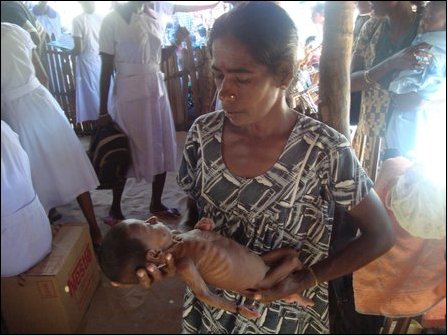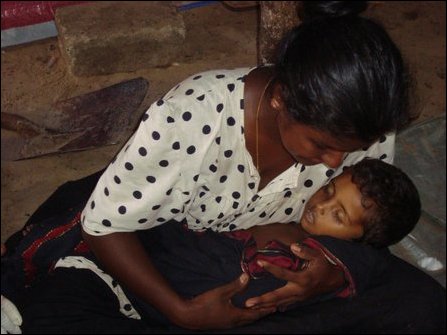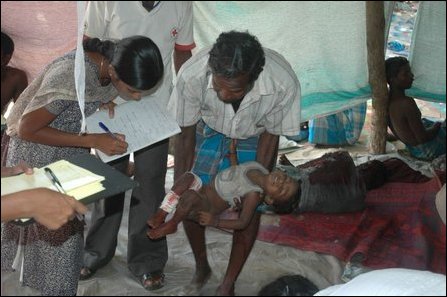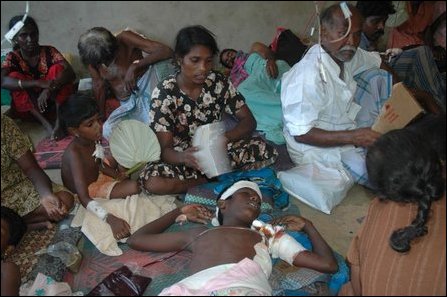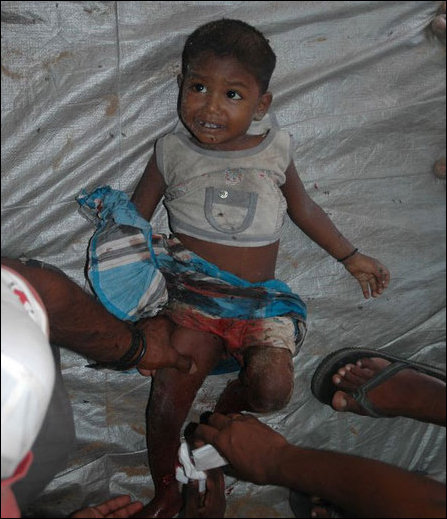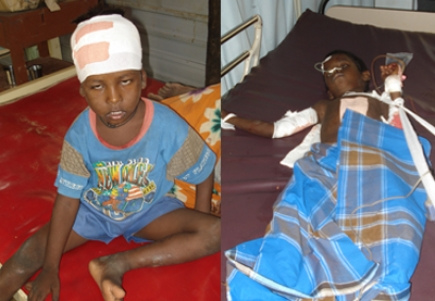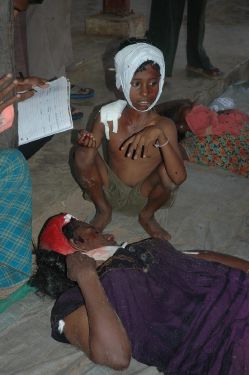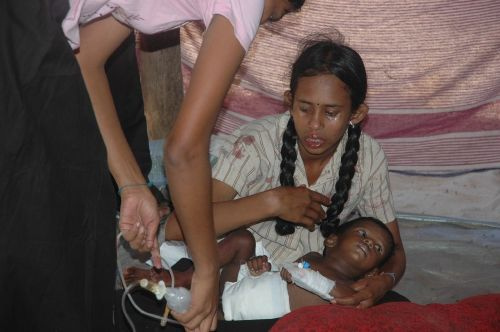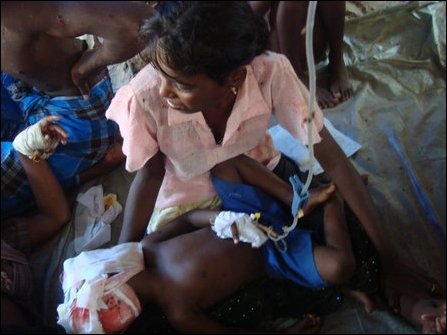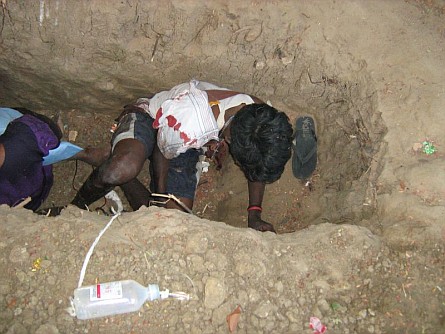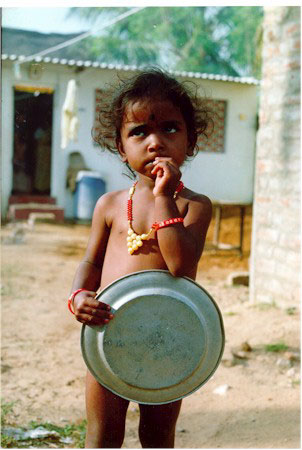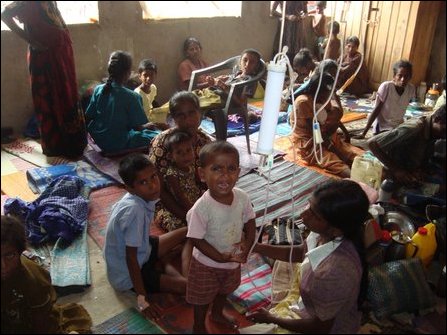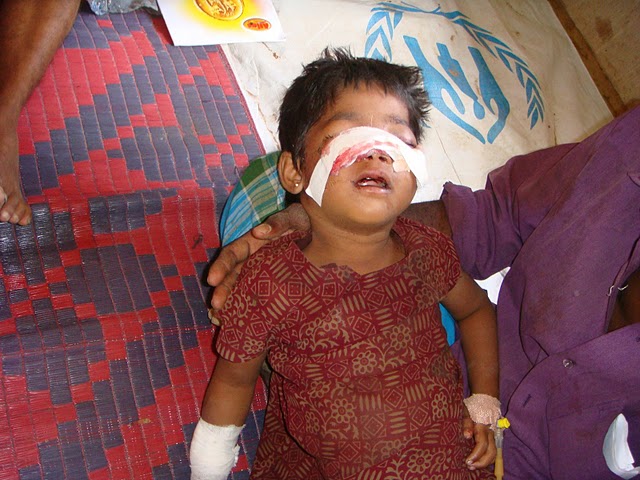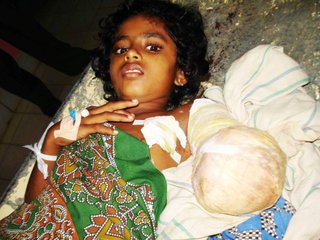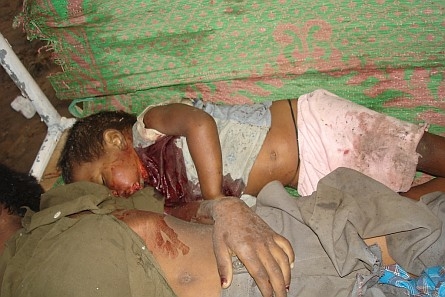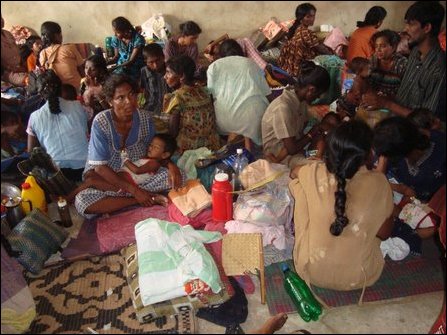From the Open-Publishing Calendar
From the Open-Publishing Newswire
Indybay Feature
SRILANKA GENOCIDE & WAR CRIME: WAR AGAINST CHILDRENS
SRILANKA GENOCIDE & WAR CRIME: WAR AGAINST CHILDRENS
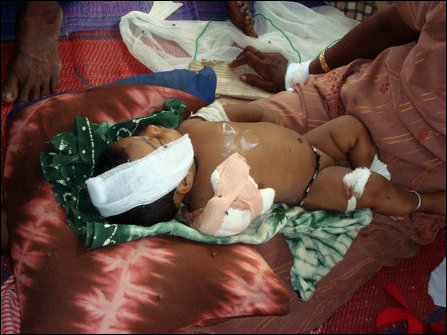
Children from the Northeast are the part of the island’s population that has been most seriously affected by the war. Children from the Northeast have been particularly at risk from malnutrition, poor health care and education, displacement, shelling and aerial bombing, disappearance, torture, rape, mass arrest and prolonged detention. Efforts by the security forces to eliminate the rebels in the areas the military controls, attempts to weaken the indigenous population in areas the LTTE controls, and general indifference by the government to a politically and economically marginalized community have all contributed to the miserable condition of these, primarily Tamil, children.
Since the ceasefire came into effect in February 2002, the situation throughout the island has improved significantly. There has been no further displacement, no further shelling, more personal security, more freedom of movement and more provision of supplies to previously isolated populations. There are efforts to de-mine some areas and some people have started returning to their homes. Few funds are available for rehabilitation, however, and political arrangements and areas of responsibility have still to be finalized, so improvements in health, education and the economic situation of the family are taking place only slowly.
UNICEF estimates that there are 900,000 children in the Northeast, all of whom have been seriously affected by the war, either through a lack of education, food, shelter or by direct injury.(UNICEF, A Special Program for Assistance for Children and Women Affected by Armed Conflict in Sri Lanka 2000-2001, Colombo, Sri Lanka, March, 1999) If one adds children affected by the war outside the Northeast, which include Sinhalese children, a rough estimate of 1 million war-affected children can be presumed. These large numbers, plus the longevity and the sustainable chaos of the conflict, are the reasons war-affected children in Sri Lanka deserve more attention.
An estimated 300,000 children are displaced due to the war (Reuters, ‘Sri Lankan children plead for peace, compassion,’ April 30, 2002), most having moved multiple times. 270,000 of these are Tamil children. (D.B.S. Jeyaraj, ‘War affected Tamil children of the North-East,’ The Sunday Leader, March 24, 2002) Half the Tamil population has been displaced at least once during the war, many of whom remain displaced. Well over a million Tamils have fled overseas, roughly one in four.(D. Sriskandarajah, ‘The Migration-Development Nexus: Sri Lanka case study,’ Center for Development Research, Denmark, Feb., 2002) Sri Lanka is seventh in the world in number of internally displaced persons.(UNHCR Global IDP Project, 2001) A roughest estimate of the number of children killed in the war is 35,000 out of probable total direct casualties of 70-80,000. Joseph Pararajasingam, MP, says that there are 6,000 war orphans in Batticaloa district.
Of the million Tamil IDPs, UNHCR estimates that about about 235,000 have returned to their home area with little or no assistance since the February, 2002 ceasefire. It is not known how many of the returnees are children. However, along with people returning to their homes, the absolute number of IDPs counted keeps rising, so in November, UNICEF’s Ted Chaiban said that about three quarters of the 400,000 school-age population in the war-hit regions lived as refugees. (AP, Nov. 22, 2002) The previous undercounting of affected populations was one of the least savory aspects of the war.
Infant mortality - Indicators of general well-being of children in the war zones declined dramatically during the 19 years of war. Infant mortality has at least quadrupled in the Jaffna peninsula since the start of the war and is at least twice the rest of Sri Lanka.(Medical Institute of Tamils, London, Oct. 1997) In a 1993 survey in Jaffna, the infant mortality rate was 41/1000 live births, compared to 23 for the island as a whole.(N. Sivarajah, MD, Proceedings of the International Conference on Health, London, Sept., 1994) Today the infant mortality rate for southern Sri Lanka is 14/1000 (The Island, June12, 2002), while that in the Northeast has undoubtedly risen. There has been a three-fold increase in low birth weight babies, to one in five of all newborns, in the Northeast since the war began. Maternal mortality is at least twice as high as the rest of the country.(MIOT, op.cit.) Anemia is found in a high proportion of pregnant & lactating women. (N. Sivarajah, op.cit.) Only 34 of 108 midwife positions in the Vanni (areas of the north controlled by the LTTE) are filled. (MSF, ‘Sri Lanka’s health service is a casualty of 20 years of war,’ Feb. 9, 2002)
Malnutrition - Malnutrition among children in areas not under government control is roughly estimated to be over 60% by Redd Barna and other NGOs. 68% of the children returning to government-controlled Trincomalee since the ceasefire are underweight.(TamilNet, May 5, 2002) In 2000 the Poverty Impact Monitoring Unit surveyed Trincomalee District and found that stunting of children was 42% for Tamils in areas held by the LTTE, 34% for Tamils in army-controlled areas, 17% for Muslims and 15% for Sinhalese. Wasting, or acute malnutrition was 13% at the national level, but 38% for Tamils in ‘uncleared’ areas, 27% in ‘cleared’ areas, 25% among Sinhalese and 14% among Muslims. Displacement, poor living conditions, poor personal and environmental hygiene, seasonal food shortages, infectious diseases, lack of access to health services, inadequate maternal and child care, poor education and lack of income were blamed for the malnutrition found.(Sunday Observer, March 19, 2000) In LTTE areas these factors have been compounded by undercounting of the displaced population and delays in getting allocated rations to those qualifying. The government has taken sole responsibility for providing for those in need, so outside organizations cannot supplement its rations.
A recent survey by the University of Jaffna of the population in IDP camps in the Jaffna peninsula - 40% of the total population of 500,000 - showed that 23% of the children under 5 are wasted, 36% are stunted and the remaining are small for their age. In 1976, before the war, only 4% of the children in the area were wasted, half the national average.(N. Sivarajah, MD, ‘Nutritional Survey of Welfare Centres in Jaffna District,’ WFP, Feb./March 2001 in Tamil Times, May 15, 2001)
A major cause of malnutrition, dropping out of school, etc. is poverty. The economy of all of Sri Lanka has been affected by the war, but that of the Northeast has been devastated. For instance, fishing in this area, the main source of protein, has declined by 63% since 1982 and agricultural output by 47%. In 1998 the Ministry of Rehabilitation compiled the following estimate of families in which the main breadwinner has been lost, Mullaitheevu - 55%, Batticaloa - 41%, Kilinochchi - 30%, Ampara - 27%, Jaffna - 25%, Trincomalee - 17%, Vavuniya -5%. (D.B.S. Jeyaraj, op.cit.)
Health - The UNICEF publication, "A Program for Special Assistance for Children and Women Affected by Armed Conflict in Sri Lanka 2000 – 2001" states, "Children’s right to survival is seriously threatened by the particularly dilapidated state of the health services infrastructure, severe shortages of doctors, midwives and public health inspectors that mean that unqualified health volunteers are left in charge of caring for the population."(1999)
According to MSF, "Most medical professionals have fled [conflict areas of the north]...Population displacement has led to a rise in infectious diseases and malnutrition. As a result, malaria has increased 20-fold since the conflict began...For seven years many essential supplies to the Wanni, including basic items such as sutures, surgical gloves, and oxygen, were subject to government embargo, and drugs and medical materials are often critically low."(MSF, ‘Sri Lanka’s health service is a casualty of 20 years of war,’ Feb. 9, 2002) In 1997 and 1998 53% of malaria patients in Sri Lanka were in the north, while 80% of the country’s deaths occurred there.(Canadian Tamil Congress, ‘A Forgotten Generation: the effect of the civil conflict on Tamil children in the North and East of Sri Lanka,’ Fall, 2001)
"Relief agency representatives are often afraid to speak out, fearing that they will be denied access to the region...In September, 1995, the ICRC issued a press release on the bombing of a church in Navaly, Jaffna in which many displaced civilians were killed. Immediately afterwards the Red Cross ship...was banned from travelling to the North."(Medical Institute of Tamils, London, Oct. 1997)
Trauma - "In the civil war that has been in progress for almost two decades children have been traumatised by common experiences such as shelling, helicopter strafing, round ups, cordon and search operations, deaths, injury, destruction, mass arrests, detention, shooting, grenade explosions, and landmines." (D. Somasundaram, ‘Child Soldiers:Understanding the Context,’ British Medical Journal, May 25, 2002) "Growing up displaced and in a heavily militarised environment can lead to psychological stress, family break-up, dispair, alcoholism, violence and suicides."(UNICEF, ‘Sri Lankan Children in Crisis,’ July 20, 2001) Nearly 25 percent of children in conflict areas have lost one or both parents, either to death or displacement.(Times of India, Sept. 7, 2002) Suicide among children, even those under 10, is alarmingly high, especially in IDP camps.
Medecins Sans Frontiers did a survey on Nov. 17, 2000 amongst the inhabitants of the government-controlled IDP camps or ‘welfare centers,’ in Vavuniya, who are Tamils from the north who have fled the war, yet are not allowed to leave Vavuniya. Approximately 175,000 people were in these camps at the time, approximately 50% of whom were children.(Canadian Tamil Congress, op.cit.) Some of these people have been in IDP camps for over 15 years, according to Dr. Jayawardene, current Sri Lankan Minister of Rehabilitation. MSF reports that, "It would be difficult to imagine a group of people suffering more from the psychological trauma of war. They have been the direct victims and witnesses of war and human rights abuses, they have been cut off from employment and the hope of self-reliance, and remain confined to squalid conditions that amplify the psychological trauma of the past and exacerbate mental health problems." The suicide rate in the centers is 103 per 10,000, three times the national average. 12% of the people in the survey had been attacked, 28% had been arrested or kidnapped, 17% had been taken hostage or detained, 17% had been maltreated by police or army personnel and 11% tortured. 7% of those in the welfare centers had lost a partner, 9% a child, 12% parents, 18% a sibling, 10% a grandparent. Almost 50% were seperated from family members and a quarter had family members who had attempted suicide. On average the people had been displaced 3 times before reaching the centers.(MSF, ‘Psychological trauma of the civil war in Sri Lanka’, The Lancet, April 27, 2002)
Surveys in schools in Jaffna district showed the following war stress in adolescents: threat to life - 25%, injury - 7%, detention - 6%, torture - 4%, war death of a relation - 32%, witnessing violence - 39%, displacement (before 1995) - 39%, lack of food - 15%, economic problems -34%, with a mean number of stresses per child of 4.( D. Somasundaram, op.cit.)
In a survey done of 170 Tamil and Muslim school children done in 2000 in Batticaloa by Dr. Robert Chase, the following exposure to war had occurred to these children: disrupted schooling and displacement of home, multiple occasions - 90%, direct exposure to shelling, shooting and/or bombing- 89%, extreme poverty and deprivation due to the war, e.g. going without home, food or water - 80%, seeing dead bodies- 53%, disappearance of family member (following abduction or detention, presumed dead) - 19%, forced separation from parents for longer than one month - 15%, direct family member killed by war fighting -15%. (The Butterfly Garden, 2000)
Education - Education in the Northeast has been severely affected by the war, both in the percentages of children attending school and the quality of education. Literacy was over 80% before the war and 99% of children attended school up to Grade 5 before 1990. The Education Ministry says that 75,000 students enrolled in the first year of primary school in the war zones this January, compared to 40,000 to 50,000 who enrolled each year during the war. This means that at least one third of the children from these areas were not in school as a result of the war. (AP, ‘Sri Lanka’s peace bid encouraging more children to go to school,’ Jan. 10, 2003) Last year the ex-UNICEF resident representative, Elroy Gabrielle, said that in the Northeast as a whole 1 in 5 children do not attend school, while the national average is 14% of children not in school.(TamilNet, Jan.20, 2002) 150 schools had army camps or sentry posts established in them before the ceasefire.(TamilNet, Jan. 14, 2002) 20 schools in the Jaffna peninsula were entirely occupied by the Sri Lankan armed forces.(http://www.eelamnation.com, Jan.8, 2002) One of the terms of the February, 2002 ceasefire is that the military must move out of schools and other public buildings. The letter of this agreement has been followed in the main, yet in many cases the camps have been moved directly adjacent to the schools, so intimidation still occurs.
There are 1,989 schools in the Northeast according to official sources, of which only 1,817 are functioning. 172 have shut due to the war.(Ceylon Daily News, Dec. 13, 2002) 300 schools have been displaced because of fighting according to the Ceylon Tamil Teachers’ Union.(TamilNet, Jan. 14, 2002) The number of schools functioning in each of the 8 districts (followed by the number temporarily closed in parentheses) is: Jaffna - 402 (85), Mannar - 94 (21), Kilinochchi - 90 (4), Mullaithivu - 95 (10), Vavuniya - 181 (12), Trincomalee - 248 (23), Batticaloa - 307 (13), Ampara - 400 (4). The total school population in these districts is over 650,000 (Ceylon Daily News, Dec. 13, 2001)
The Ceylon Tamil Teachers’ Union said in February, 2001 that there are 95,000 students in the uncleared parts of the Vanni, while the Northeast Provincial Education Ministry claims there are only 87,000 - one of the numerous instances of undercounting of a vulnerable population by the government. Tamils are quite bitter at the world’s acquiescence in this practice.
A 1999 survey done in the Jaffna peninsula by the University of Jaffna and Save the Children Fund UK found that 27,000 children do not attend school at all. A further 23,000 children do not attend school on a regular basis. 17,700 children are displaced, 1,200 children have recognizable disabilities, while 9,200 children are employed and 6,900 children are married. UNICEF says the increasing number of children dropping out of school is due to a shortage of trained teachers and the need for children to supplement their families’ income.(Carol Bellamy, UNICEF, ‘Sri Lankan Children in Crisis,’ July 20, 2001) In May, 2001 an officer of the government’s Excise Dept. said that the government sends Jaffna liquor (on the ships that were Jaffna’s only supply line until very recently) more regularly than textbooks. He said each textbook was shared by 3 children.(TamilNet, May 8, 2001) A World Bank official on a mission to Jaffna said that there are 128,000 students in the Jaffna peninsula and 862 teachers, so each teacher is responsible for 148 students. (Virakesari, Sept.12, 2001) A report submitted to the Ministry of Education by the Ceylon Teachers’ Union gives the following figures collected from the schools in the ‘uncleared’ areas of the north: Kilinochchi zone - students 36,872, teachers 766, Mullaitivu zone - students 24,296, teachers 515, Thunukai zone - students 15, 801, teachers 320, Madhu - students 8, 182, teachers 184, Vavuniya north - students 9,123, teachers 228. Over half of the teachers in these areas are volunteers, many untrained. (TamilNet, March 24, 2001)
Because of displacement and other reasons for nonattendance at school, a large scale program to allow children to catch up to their own age group is needed. The Norwegian Refugee Council noted, "Due to multi displacement, children have lost the continuity of education and some have lost one or two years of schooling. This makes the children difficult to adjust to the normal curriculum."(cited in Canadian Tamil Congress, op.cit.) US$ 40 million is an initial estimate of the cost of rebuilding educational infrastructure in the Northeast. (AP, Nov.22, 2002)
Security forces & children - "Tamil youths are specifically targeted by Sinhala security forces in their checking, cordon and search operations, and they are often detained for interrogation, torture, execution, or even rape."(Somasundaram, op.cit.) Adolescents have disappeared on a regular basis over the course of the war. 15% of the 600 people who disappeared in 1996 in the Jaffna peninsula were children.(Somasundaram, op.cit.) According to Amnesty International, torture by security forces is ‘among the most common human rights violations reported’ and is ‘reported almost (if not) daily.’(ASA 37/10/99, ‘Sri Lanka: Torture in Custody,’ June, 1999) Rape of girls in areas under army control is a major problem, with allegations of 150 cases per year in the northeast by police and security forces.(Tamil Centre for Human Right, ‘TCHR Statistics on Rape,’ Human Rights of Tamils, Feb. 2000 & Canadian Tamil Congress, op.cit.) while rape of both boys and girls in detention is common.(D. Peel, M. Mahtani, A. Hinshelwood, G. Forrest, ‘The sexual abuse of men in detention in Sri Lanka,’ The Lancet, June 10, 2000) Impunity by the security forces for these crimes is complete.(Amnesty, Human Rights Watch, US Dept. of State, various dates) Forced labor at army and Special Task Force camps, particularly in the East, is often reported.(TamilNet, Feb. 18, 1999 and personal communication) Restrictions on freedom of movement for young people was a serious problem until the ceasefire.
Children in Prison - Arbitrary arrest and long term detention under the Prevention of Terrorism Act (PTA) was common until the ceasefire. Of the hundreds of Tamils who are now in prison without charge, some for as long as 5 years, a certain number are under 18. In October, 2000 26 inmates of the Bindunuwewa camp housing suspected to be members of the LTTE were killed in a mob attack. All were between 14 and 23. 150 children under age 5 are held with their parents who have been detained under the PTA.(TamilNet, March 23, 2002)
Child Soldiers - The issue of child soldiers has become entwined with politics in Sri Lanka, with those government entities, media and NGOs against the peace negotiations, including parts of the UN (for example, ‘The Situation of IDPs in Sri Lanka: Report of a mission of the Internal Displacement Unit,’ OCHA, April, 2002), using allegations concerning the use of child soldiers to assert that 1.) the LTTE is not a trustworthy partner for peace negotiations and 2.) the LTTE should be allowed no administrative functions as a result of these negotiations. Those studying the issue must be careful not to accept ideologically-driven sources at face value. As a result of this political focus, the embargo on entry to the northeast, media control by those sympathetic to the government and the single issue blinders of the child soldier lobby, other issues of concern to war-affected children have been substantially ignored, especially those of food, health, education, security and long-term detention, most of which constitute war crimes or human rights violations in their own right and have had a much wider impact on the one million war-affected children. One need look no further than the difference between the amount of commentary given the commitments made by the government and the LTTE to the SRSGCAC during his visit in 1998 for evidence of this disparity.
Pres. Kumaratunge, in an interview with CNN on May 16, 2002, estimated that there are 1,000 soldiers under 18 in the LTTE armed forces. Due to the military-enforced embargo around LTTE areas until recently and the known intelligence weakness of the Sri Lankan forces, it is hard to understand how she came up with this figure. As the LTTE have an estimated 10,000 soldiers, Kumaratunge’s figure would lead to a ratio of 1 underage in 10. As entry into LTTE areas is now allowed, this is an issue of discussion and observation instead of hypothesis, as has been the case with most ‘authorities’ of past years who have not had access to the areas they studied.
Landmines - The Northeast of Sri Lanka is one of the most heavily mined areas of the world - comparable to Angola. Unlike many countries, the most heavily mined areas are inhabited. Mines in fields and around schools are particular problems. Children are thus frequently landmine victims. According to Jeyaraj, a survey of civilians treated at the Jaffna hospital for landmine injuries showed that 20% of the victims were under 15 years old, while 38% of those fitted with artificial limbs at the Jaffna Jaipur foot workshop were under 20 years old.(op.cit.) In 1998, there were 15 landmine incidents every month.(US Dept. Of State, ‘Hidden Killers: The Global Landmine Crisis’) A UN de-mining program in Jaffna in 1999 and 2000 removed a certain number of mines, but many more were planted during this period. Today the US State Dept. and the HALO Trust are funding de-mining in the Jaffna peninsula and the LTTE is de-mining in areas it controls. There are an estimated 1.4 million pieces of live ammunition, including 86,700 anti-personnel mines, remaining in territory controlled by the LTTE.(TamilNet, May 23, 2002)
BACKGROUND
Since 1983 there has been active fighting between the Sri Lankan government security forces, and the Liberation Tigers of Tamil Eelam (LTTE or ‘Tigers’), who seek more political autonomy for the Tamil nation. Both conventional and guerrilla tactics are used by both sides. The security forces are predominantly Sinhalese and have about 120,000 people under arms, including the militarized police, while the LTTE have 10-15,000. Irregular forces include the government-sponsored Home Guard, several paramilitary Tamil groups that cooperate with the security forces against the LTTE, and the LTTE Border Force. Efforts at peacemaking, most notably a high profile Norwegian role over the past 2 years, have resulted in a ceasefire that has now held for 12 months. Discussions concerning administrative and political arrangements are taking place, but little substantive has been accomplished to assist the civilian population beyond an end to fighting and an easing of the blockade.
In the 18 years of war in Sri Lanka the fighting and physical destruction has been primarily confined to the North and East Provinces, barring isolated incidents. (Just as an analysis of the war in Chechnya must separate Chechnyan information from more general Russian information, so one must be careful to obtain information about children in the areas of conflict, rather that for children in Sri Lanka more generally.) As in many such conflicts, the civilian population of the Northeast has been targeted by the security forces in an effort to weaken the support base of the Tamil rebels. Civilian areas, including schools, hospitals, markets, places of worship, agricultural resources and even entire towns and villages, have been regularly destroyed by the armed forces.
Large areas of the Northeast were blockaded by the armed forces for over a decade with no electricity and limited food, medicine, fuel, agricultural inputs or other items allowed entry. This embargo has been significantly, but not entirely, eased over the past 12 months as a result of the agreements resulting in the ceasefire. Movement into or out of these areas by residents or outsiders was highly restricted. Because access to this population was permitted to only a few UN agencies and NGOs under many limitations, information concerning them, including their exact numbers, have been hard to come by and highly politicized. Fighting has been active and front lines changed frequently, which added to the difficulty in obtaining accurate information. Statistics concerning the Jaffna Peninsula are the most comprehensive because of the concentrated population, higher levels of education and wealth and the presence of a university.
At the present time, in the Northern Province the government controls the Jaffna Peninsula and a stretch of territory on the southern reaches from Mannar in the West to Vavuniya and east to the sea. The LTTE control the central part of the Northern Province, called the ‘Vanni.’ About 500,000 people live in the Jaffna Peninsula, another 500,000 live in the Vanni, and over 1 million live in the East. About 300,000 Tamils live in Colombo, many of whom have fled from the war zone. In the Eastern Province, the government controls the port of Trincomalee and the town of Batticaloa along the coast and the LTTE controls the hinterlands. The government controls most of Amparai. The children who live in Jaffna, the Vanni and the LTTE-controlled areas of the East have been most at risk because of the destruction of the economy, the lack of access by aid-givers, restrictions on movement, military offenses, shelling and aerial bombing. Even those Tamils that live in government-controlled areas have had difficulties because of restrictions on movement, few restraints on the armed forces, arbitrary arrest and detention and neglect by government programs.
http://fast1.onesite.com/my.telegraph.co.uk/user/richarddixons/aa986bd3313e55319a79d784b5802d06.jpg?v=148630
Since the ceasefire came into effect in February 2002, the situation throughout the island has improved significantly. There has been no further displacement, no further shelling, more personal security, more freedom of movement and more provision of supplies to previously isolated populations. There are efforts to de-mine some areas and some people have started returning to their homes. Few funds are available for rehabilitation, however, and political arrangements and areas of responsibility have still to be finalized, so improvements in health, education and the economic situation of the family are taking place only slowly.
UNICEF estimates that there are 900,000 children in the Northeast, all of whom have been seriously affected by the war, either through a lack of education, food, shelter or by direct injury.(UNICEF, A Special Program for Assistance for Children and Women Affected by Armed Conflict in Sri Lanka 2000-2001, Colombo, Sri Lanka, March, 1999) If one adds children affected by the war outside the Northeast, which include Sinhalese children, a rough estimate of 1 million war-affected children can be presumed. These large numbers, plus the longevity and the sustainable chaos of the conflict, are the reasons war-affected children in Sri Lanka deserve more attention.
An estimated 300,000 children are displaced due to the war (Reuters, ‘Sri Lankan children plead for peace, compassion,’ April 30, 2002), most having moved multiple times. 270,000 of these are Tamil children. (D.B.S. Jeyaraj, ‘War affected Tamil children of the North-East,’ The Sunday Leader, March 24, 2002) Half the Tamil population has been displaced at least once during the war, many of whom remain displaced. Well over a million Tamils have fled overseas, roughly one in four.(D. Sriskandarajah, ‘The Migration-Development Nexus: Sri Lanka case study,’ Center for Development Research, Denmark, Feb., 2002) Sri Lanka is seventh in the world in number of internally displaced persons.(UNHCR Global IDP Project, 2001) A roughest estimate of the number of children killed in the war is 35,000 out of probable total direct casualties of 70-80,000. Joseph Pararajasingam, MP, says that there are 6,000 war orphans in Batticaloa district.
Of the million Tamil IDPs, UNHCR estimates that about about 235,000 have returned to their home area with little or no assistance since the February, 2002 ceasefire. It is not known how many of the returnees are children. However, along with people returning to their homes, the absolute number of IDPs counted keeps rising, so in November, UNICEF’s Ted Chaiban said that about three quarters of the 400,000 school-age population in the war-hit regions lived as refugees. (AP, Nov. 22, 2002) The previous undercounting of affected populations was one of the least savory aspects of the war.
Infant mortality - Indicators of general well-being of children in the war zones declined dramatically during the 19 years of war. Infant mortality has at least quadrupled in the Jaffna peninsula since the start of the war and is at least twice the rest of Sri Lanka.(Medical Institute of Tamils, London, Oct. 1997) In a 1993 survey in Jaffna, the infant mortality rate was 41/1000 live births, compared to 23 for the island as a whole.(N. Sivarajah, MD, Proceedings of the International Conference on Health, London, Sept., 1994) Today the infant mortality rate for southern Sri Lanka is 14/1000 (The Island, June12, 2002), while that in the Northeast has undoubtedly risen. There has been a three-fold increase in low birth weight babies, to one in five of all newborns, in the Northeast since the war began. Maternal mortality is at least twice as high as the rest of the country.(MIOT, op.cit.) Anemia is found in a high proportion of pregnant & lactating women. (N. Sivarajah, op.cit.) Only 34 of 108 midwife positions in the Vanni (areas of the north controlled by the LTTE) are filled. (MSF, ‘Sri Lanka’s health service is a casualty of 20 years of war,’ Feb. 9, 2002)
Malnutrition - Malnutrition among children in areas not under government control is roughly estimated to be over 60% by Redd Barna and other NGOs. 68% of the children returning to government-controlled Trincomalee since the ceasefire are underweight.(TamilNet, May 5, 2002) In 2000 the Poverty Impact Monitoring Unit surveyed Trincomalee District and found that stunting of children was 42% for Tamils in areas held by the LTTE, 34% for Tamils in army-controlled areas, 17% for Muslims and 15% for Sinhalese. Wasting, or acute malnutrition was 13% at the national level, but 38% for Tamils in ‘uncleared’ areas, 27% in ‘cleared’ areas, 25% among Sinhalese and 14% among Muslims. Displacement, poor living conditions, poor personal and environmental hygiene, seasonal food shortages, infectious diseases, lack of access to health services, inadequate maternal and child care, poor education and lack of income were blamed for the malnutrition found.(Sunday Observer, March 19, 2000) In LTTE areas these factors have been compounded by undercounting of the displaced population and delays in getting allocated rations to those qualifying. The government has taken sole responsibility for providing for those in need, so outside organizations cannot supplement its rations.
A recent survey by the University of Jaffna of the population in IDP camps in the Jaffna peninsula - 40% of the total population of 500,000 - showed that 23% of the children under 5 are wasted, 36% are stunted and the remaining are small for their age. In 1976, before the war, only 4% of the children in the area were wasted, half the national average.(N. Sivarajah, MD, ‘Nutritional Survey of Welfare Centres in Jaffna District,’ WFP, Feb./March 2001 in Tamil Times, May 15, 2001)
A major cause of malnutrition, dropping out of school, etc. is poverty. The economy of all of Sri Lanka has been affected by the war, but that of the Northeast has been devastated. For instance, fishing in this area, the main source of protein, has declined by 63% since 1982 and agricultural output by 47%. In 1998 the Ministry of Rehabilitation compiled the following estimate of families in which the main breadwinner has been lost, Mullaitheevu - 55%, Batticaloa - 41%, Kilinochchi - 30%, Ampara - 27%, Jaffna - 25%, Trincomalee - 17%, Vavuniya -5%. (D.B.S. Jeyaraj, op.cit.)
Health - The UNICEF publication, "A Program for Special Assistance for Children and Women Affected by Armed Conflict in Sri Lanka 2000 – 2001" states, "Children’s right to survival is seriously threatened by the particularly dilapidated state of the health services infrastructure, severe shortages of doctors, midwives and public health inspectors that mean that unqualified health volunteers are left in charge of caring for the population."(1999)
According to MSF, "Most medical professionals have fled [conflict areas of the north]...Population displacement has led to a rise in infectious diseases and malnutrition. As a result, malaria has increased 20-fold since the conflict began...For seven years many essential supplies to the Wanni, including basic items such as sutures, surgical gloves, and oxygen, were subject to government embargo, and drugs and medical materials are often critically low."(MSF, ‘Sri Lanka’s health service is a casualty of 20 years of war,’ Feb. 9, 2002) In 1997 and 1998 53% of malaria patients in Sri Lanka were in the north, while 80% of the country’s deaths occurred there.(Canadian Tamil Congress, ‘A Forgotten Generation: the effect of the civil conflict on Tamil children in the North and East of Sri Lanka,’ Fall, 2001)
"Relief agency representatives are often afraid to speak out, fearing that they will be denied access to the region...In September, 1995, the ICRC issued a press release on the bombing of a church in Navaly, Jaffna in which many displaced civilians were killed. Immediately afterwards the Red Cross ship...was banned from travelling to the North."(Medical Institute of Tamils, London, Oct. 1997)
Trauma - "In the civil war that has been in progress for almost two decades children have been traumatised by common experiences such as shelling, helicopter strafing, round ups, cordon and search operations, deaths, injury, destruction, mass arrests, detention, shooting, grenade explosions, and landmines." (D. Somasundaram, ‘Child Soldiers:Understanding the Context,’ British Medical Journal, May 25, 2002) "Growing up displaced and in a heavily militarised environment can lead to psychological stress, family break-up, dispair, alcoholism, violence and suicides."(UNICEF, ‘Sri Lankan Children in Crisis,’ July 20, 2001) Nearly 25 percent of children in conflict areas have lost one or both parents, either to death or displacement.(Times of India, Sept. 7, 2002) Suicide among children, even those under 10, is alarmingly high, especially in IDP camps.
Medecins Sans Frontiers did a survey on Nov. 17, 2000 amongst the inhabitants of the government-controlled IDP camps or ‘welfare centers,’ in Vavuniya, who are Tamils from the north who have fled the war, yet are not allowed to leave Vavuniya. Approximately 175,000 people were in these camps at the time, approximately 50% of whom were children.(Canadian Tamil Congress, op.cit.) Some of these people have been in IDP camps for over 15 years, according to Dr. Jayawardene, current Sri Lankan Minister of Rehabilitation. MSF reports that, "It would be difficult to imagine a group of people suffering more from the psychological trauma of war. They have been the direct victims and witnesses of war and human rights abuses, they have been cut off from employment and the hope of self-reliance, and remain confined to squalid conditions that amplify the psychological trauma of the past and exacerbate mental health problems." The suicide rate in the centers is 103 per 10,000, three times the national average. 12% of the people in the survey had been attacked, 28% had been arrested or kidnapped, 17% had been taken hostage or detained, 17% had been maltreated by police or army personnel and 11% tortured. 7% of those in the welfare centers had lost a partner, 9% a child, 12% parents, 18% a sibling, 10% a grandparent. Almost 50% were seperated from family members and a quarter had family members who had attempted suicide. On average the people had been displaced 3 times before reaching the centers.(MSF, ‘Psychological trauma of the civil war in Sri Lanka’, The Lancet, April 27, 2002)
Surveys in schools in Jaffna district showed the following war stress in adolescents: threat to life - 25%, injury - 7%, detention - 6%, torture - 4%, war death of a relation - 32%, witnessing violence - 39%, displacement (before 1995) - 39%, lack of food - 15%, economic problems -34%, with a mean number of stresses per child of 4.( D. Somasundaram, op.cit.)
In a survey done of 170 Tamil and Muslim school children done in 2000 in Batticaloa by Dr. Robert Chase, the following exposure to war had occurred to these children: disrupted schooling and displacement of home, multiple occasions - 90%, direct exposure to shelling, shooting and/or bombing- 89%, extreme poverty and deprivation due to the war, e.g. going without home, food or water - 80%, seeing dead bodies- 53%, disappearance of family member (following abduction or detention, presumed dead) - 19%, forced separation from parents for longer than one month - 15%, direct family member killed by war fighting -15%. (The Butterfly Garden, 2000)
Education - Education in the Northeast has been severely affected by the war, both in the percentages of children attending school and the quality of education. Literacy was over 80% before the war and 99% of children attended school up to Grade 5 before 1990. The Education Ministry says that 75,000 students enrolled in the first year of primary school in the war zones this January, compared to 40,000 to 50,000 who enrolled each year during the war. This means that at least one third of the children from these areas were not in school as a result of the war. (AP, ‘Sri Lanka’s peace bid encouraging more children to go to school,’ Jan. 10, 2003) Last year the ex-UNICEF resident representative, Elroy Gabrielle, said that in the Northeast as a whole 1 in 5 children do not attend school, while the national average is 14% of children not in school.(TamilNet, Jan.20, 2002) 150 schools had army camps or sentry posts established in them before the ceasefire.(TamilNet, Jan. 14, 2002) 20 schools in the Jaffna peninsula were entirely occupied by the Sri Lankan armed forces.(http://www.eelamnation.com, Jan.8, 2002) One of the terms of the February, 2002 ceasefire is that the military must move out of schools and other public buildings. The letter of this agreement has been followed in the main, yet in many cases the camps have been moved directly adjacent to the schools, so intimidation still occurs.
There are 1,989 schools in the Northeast according to official sources, of which only 1,817 are functioning. 172 have shut due to the war.(Ceylon Daily News, Dec. 13, 2002) 300 schools have been displaced because of fighting according to the Ceylon Tamil Teachers’ Union.(TamilNet, Jan. 14, 2002) The number of schools functioning in each of the 8 districts (followed by the number temporarily closed in parentheses) is: Jaffna - 402 (85), Mannar - 94 (21), Kilinochchi - 90 (4), Mullaithivu - 95 (10), Vavuniya - 181 (12), Trincomalee - 248 (23), Batticaloa - 307 (13), Ampara - 400 (4). The total school population in these districts is over 650,000 (Ceylon Daily News, Dec. 13, 2001)
The Ceylon Tamil Teachers’ Union said in February, 2001 that there are 95,000 students in the uncleared parts of the Vanni, while the Northeast Provincial Education Ministry claims there are only 87,000 - one of the numerous instances of undercounting of a vulnerable population by the government. Tamils are quite bitter at the world’s acquiescence in this practice.
A 1999 survey done in the Jaffna peninsula by the University of Jaffna and Save the Children Fund UK found that 27,000 children do not attend school at all. A further 23,000 children do not attend school on a regular basis. 17,700 children are displaced, 1,200 children have recognizable disabilities, while 9,200 children are employed and 6,900 children are married. UNICEF says the increasing number of children dropping out of school is due to a shortage of trained teachers and the need for children to supplement their families’ income.(Carol Bellamy, UNICEF, ‘Sri Lankan Children in Crisis,’ July 20, 2001) In May, 2001 an officer of the government’s Excise Dept. said that the government sends Jaffna liquor (on the ships that were Jaffna’s only supply line until very recently) more regularly than textbooks. He said each textbook was shared by 3 children.(TamilNet, May 8, 2001) A World Bank official on a mission to Jaffna said that there are 128,000 students in the Jaffna peninsula and 862 teachers, so each teacher is responsible for 148 students. (Virakesari, Sept.12, 2001) A report submitted to the Ministry of Education by the Ceylon Teachers’ Union gives the following figures collected from the schools in the ‘uncleared’ areas of the north: Kilinochchi zone - students 36,872, teachers 766, Mullaitivu zone - students 24,296, teachers 515, Thunukai zone - students 15, 801, teachers 320, Madhu - students 8, 182, teachers 184, Vavuniya north - students 9,123, teachers 228. Over half of the teachers in these areas are volunteers, many untrained. (TamilNet, March 24, 2001)
Because of displacement and other reasons for nonattendance at school, a large scale program to allow children to catch up to their own age group is needed. The Norwegian Refugee Council noted, "Due to multi displacement, children have lost the continuity of education and some have lost one or two years of schooling. This makes the children difficult to adjust to the normal curriculum."(cited in Canadian Tamil Congress, op.cit.) US$ 40 million is an initial estimate of the cost of rebuilding educational infrastructure in the Northeast. (AP, Nov.22, 2002)
Security forces & children - "Tamil youths are specifically targeted by Sinhala security forces in their checking, cordon and search operations, and they are often detained for interrogation, torture, execution, or even rape."(Somasundaram, op.cit.) Adolescents have disappeared on a regular basis over the course of the war. 15% of the 600 people who disappeared in 1996 in the Jaffna peninsula were children.(Somasundaram, op.cit.) According to Amnesty International, torture by security forces is ‘among the most common human rights violations reported’ and is ‘reported almost (if not) daily.’(ASA 37/10/99, ‘Sri Lanka: Torture in Custody,’ June, 1999) Rape of girls in areas under army control is a major problem, with allegations of 150 cases per year in the northeast by police and security forces.(Tamil Centre for Human Right, ‘TCHR Statistics on Rape,’ Human Rights of Tamils, Feb. 2000 & Canadian Tamil Congress, op.cit.) while rape of both boys and girls in detention is common.(D. Peel, M. Mahtani, A. Hinshelwood, G. Forrest, ‘The sexual abuse of men in detention in Sri Lanka,’ The Lancet, June 10, 2000) Impunity by the security forces for these crimes is complete.(Amnesty, Human Rights Watch, US Dept. of State, various dates) Forced labor at army and Special Task Force camps, particularly in the East, is often reported.(TamilNet, Feb. 18, 1999 and personal communication) Restrictions on freedom of movement for young people was a serious problem until the ceasefire.
Children in Prison - Arbitrary arrest and long term detention under the Prevention of Terrorism Act (PTA) was common until the ceasefire. Of the hundreds of Tamils who are now in prison without charge, some for as long as 5 years, a certain number are under 18. In October, 2000 26 inmates of the Bindunuwewa camp housing suspected to be members of the LTTE were killed in a mob attack. All were between 14 and 23. 150 children under age 5 are held with their parents who have been detained under the PTA.(TamilNet, March 23, 2002)
Child Soldiers - The issue of child soldiers has become entwined with politics in Sri Lanka, with those government entities, media and NGOs against the peace negotiations, including parts of the UN (for example, ‘The Situation of IDPs in Sri Lanka: Report of a mission of the Internal Displacement Unit,’ OCHA, April, 2002), using allegations concerning the use of child soldiers to assert that 1.) the LTTE is not a trustworthy partner for peace negotiations and 2.) the LTTE should be allowed no administrative functions as a result of these negotiations. Those studying the issue must be careful not to accept ideologically-driven sources at face value. As a result of this political focus, the embargo on entry to the northeast, media control by those sympathetic to the government and the single issue blinders of the child soldier lobby, other issues of concern to war-affected children have been substantially ignored, especially those of food, health, education, security and long-term detention, most of which constitute war crimes or human rights violations in their own right and have had a much wider impact on the one million war-affected children. One need look no further than the difference between the amount of commentary given the commitments made by the government and the LTTE to the SRSGCAC during his visit in 1998 for evidence of this disparity.
Pres. Kumaratunge, in an interview with CNN on May 16, 2002, estimated that there are 1,000 soldiers under 18 in the LTTE armed forces. Due to the military-enforced embargo around LTTE areas until recently and the known intelligence weakness of the Sri Lankan forces, it is hard to understand how she came up with this figure. As the LTTE have an estimated 10,000 soldiers, Kumaratunge’s figure would lead to a ratio of 1 underage in 10. As entry into LTTE areas is now allowed, this is an issue of discussion and observation instead of hypothesis, as has been the case with most ‘authorities’ of past years who have not had access to the areas they studied.
Landmines - The Northeast of Sri Lanka is one of the most heavily mined areas of the world - comparable to Angola. Unlike many countries, the most heavily mined areas are inhabited. Mines in fields and around schools are particular problems. Children are thus frequently landmine victims. According to Jeyaraj, a survey of civilians treated at the Jaffna hospital for landmine injuries showed that 20% of the victims were under 15 years old, while 38% of those fitted with artificial limbs at the Jaffna Jaipur foot workshop were under 20 years old.(op.cit.) In 1998, there were 15 landmine incidents every month.(US Dept. Of State, ‘Hidden Killers: The Global Landmine Crisis’) A UN de-mining program in Jaffna in 1999 and 2000 removed a certain number of mines, but many more were planted during this period. Today the US State Dept. and the HALO Trust are funding de-mining in the Jaffna peninsula and the LTTE is de-mining in areas it controls. There are an estimated 1.4 million pieces of live ammunition, including 86,700 anti-personnel mines, remaining in territory controlled by the LTTE.(TamilNet, May 23, 2002)
BACKGROUND
Since 1983 there has been active fighting between the Sri Lankan government security forces, and the Liberation Tigers of Tamil Eelam (LTTE or ‘Tigers’), who seek more political autonomy for the Tamil nation. Both conventional and guerrilla tactics are used by both sides. The security forces are predominantly Sinhalese and have about 120,000 people under arms, including the militarized police, while the LTTE have 10-15,000. Irregular forces include the government-sponsored Home Guard, several paramilitary Tamil groups that cooperate with the security forces against the LTTE, and the LTTE Border Force. Efforts at peacemaking, most notably a high profile Norwegian role over the past 2 years, have resulted in a ceasefire that has now held for 12 months. Discussions concerning administrative and political arrangements are taking place, but little substantive has been accomplished to assist the civilian population beyond an end to fighting and an easing of the blockade.
In the 18 years of war in Sri Lanka the fighting and physical destruction has been primarily confined to the North and East Provinces, barring isolated incidents. (Just as an analysis of the war in Chechnya must separate Chechnyan information from more general Russian information, so one must be careful to obtain information about children in the areas of conflict, rather that for children in Sri Lanka more generally.) As in many such conflicts, the civilian population of the Northeast has been targeted by the security forces in an effort to weaken the support base of the Tamil rebels. Civilian areas, including schools, hospitals, markets, places of worship, agricultural resources and even entire towns and villages, have been regularly destroyed by the armed forces.
Large areas of the Northeast were blockaded by the armed forces for over a decade with no electricity and limited food, medicine, fuel, agricultural inputs or other items allowed entry. This embargo has been significantly, but not entirely, eased over the past 12 months as a result of the agreements resulting in the ceasefire. Movement into or out of these areas by residents or outsiders was highly restricted. Because access to this population was permitted to only a few UN agencies and NGOs under many limitations, information concerning them, including their exact numbers, have been hard to come by and highly politicized. Fighting has been active and front lines changed frequently, which added to the difficulty in obtaining accurate information. Statistics concerning the Jaffna Peninsula are the most comprehensive because of the concentrated population, higher levels of education and wealth and the presence of a university.
At the present time, in the Northern Province the government controls the Jaffna Peninsula and a stretch of territory on the southern reaches from Mannar in the West to Vavuniya and east to the sea. The LTTE control the central part of the Northern Province, called the ‘Vanni.’ About 500,000 people live in the Jaffna Peninsula, another 500,000 live in the Vanni, and over 1 million live in the East. About 300,000 Tamils live in Colombo, many of whom have fled from the war zone. In the Eastern Province, the government controls the port of Trincomalee and the town of Batticaloa along the coast and the LTTE controls the hinterlands. The government controls most of Amparai. The children who live in Jaffna, the Vanni and the LTTE-controlled areas of the East have been most at risk because of the destruction of the economy, the lack of access by aid-givers, restrictions on movement, military offenses, shelling and aerial bombing. Even those Tamils that live in government-controlled areas have had difficulties because of restrictions on movement, few restraints on the armed forces, arbitrary arrest and detention and neglect by government programs.
http://fast1.onesite.com/my.telegraph.co.uk/user/richarddixons/aa986bd3313e55319a79d784b5802d06.jpg?v=148630
For more information:
http://fast1.onesite.com/my.telegraph.co.u...
Add Your Comments
We are 100% volunteer and depend on your participation to sustain our efforts!
Get Involved
If you'd like to help with maintaining or developing the website, contact us.
Publish
Publish your stories and upcoming events on Indybay.
Topics
More
Search Indybay's Archives
Advanced Search
►
▼
IMC Network


